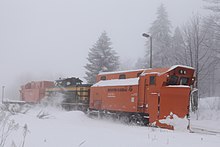Probstzella – Neuhaus railway line on Rennweg
| Probstzella-Neuhaus am Rennweg | |||||||||||||||||||||||||||||||||||||||||||||||||||||||||||||||||||||||||||||||||||||||||||||||||||||||||
|---|---|---|---|---|---|---|---|---|---|---|---|---|---|---|---|---|---|---|---|---|---|---|---|---|---|---|---|---|---|---|---|---|---|---|---|---|---|---|---|---|---|---|---|---|---|---|---|---|---|---|---|---|---|---|---|---|---|---|---|---|---|---|---|---|---|---|---|---|---|---|---|---|---|---|---|---|---|---|---|---|---|---|---|---|---|---|---|---|---|---|---|---|---|---|---|---|---|---|---|---|---|---|---|---|---|
| Route number (DB) : | 6688 | ||||||||||||||||||||||||||||||||||||||||||||||||||||||||||||||||||||||||||||||||||||||||||||||||||||||||
| Course book section (DB) : | 564 | ||||||||||||||||||||||||||||||||||||||||||||||||||||||||||||||||||||||||||||||||||||||||||||||||||||||||
| Route length: | 26.343 km | ||||||||||||||||||||||||||||||||||||||||||||||||||||||||||||||||||||||||||||||||||||||||||||||||||||||||
| Gauge : | 1435 mm ( standard gauge ) | ||||||||||||||||||||||||||||||||||||||||||||||||||||||||||||||||||||||||||||||||||||||||||||||||||||||||
|
|||||||||||||||||||||||||||||||||||||||||||||||||||||||||||||||||||||||||||||||||||||||||||||||||||||||||
The railway Probstzella-Neuhaus am Rennweg is a roughly 26-kilometer single-track branch line of the track width 1435 mm ( standard gauge ) of Probstzella to Neuhaus am Rennweg leads. Today the section from Ernstthal am Rennsteig to Neuhaus am Rennweg is still in operation.
The disused section from Schmiedefeld to Probstzella was popularly known as the Zoptetalbahn , or because of the connection between the Carl Moritz porcelain factory in Taubenbach (1848 to 1939) and the ore mines of the Maxhütte Unterwellenborn in Schmiedefeld, the Max-und-Moritz-Bahn .
history
Emergence
The older part of the railway line was built in the Saalfeld district of the Duchy of Saxony-Meiningen , which was reorganized in 1826 , the younger section in the ridge area also touched the area of the Principality of Schwarzburg-Rudolstadt in places .
Probstzella – Lichte-Ost section
The construction of the 14.6 km long northern section from Probstzella to Taubenbach was started in November 1896 by the Royal Railway Directorate Erfurt of the Prussian State Railway , which had taken over the Werra Railway Company in 1895 . On October 15, 1898, the section to Taubenbach was put into operation, the subsequent 1.6 km to Bock-Wallendorf on January 18, 1899. Here, in addition to the porcelain industry, it was above all the iron ore mines, which were acquired by Maximilianhütte Unterwellenborn in 1888 Had transport needs by rail. Until the iron ore mine was closed in December 1972, around 8.5 million tons of chamosite ore had been transported on the route.
Section Lichte-Ost – Neuhaus am Rennweg
To improve the economic and social situation of the Saxon-Meiningischen communities Bock und Teich , Piesau , Wallendorf , Ernstthal , Igelshieb and the property Bernhardsthal and the princely-Schwarzburgischen places Lichte , Geiersthal , Schmalenbuche and Neuhaus, which are located on the ridge of the Thuringian Slate Mountains, the Prussian approved House of Representatives 1909 for the project "Bock-Wallendorf - Neuhaus-Igelshieb with branch from Ernstthal to Lauscha " 5.8 million marks. The entrepreneurs in the porcelain industry in Lichte and Wallendorf had vehemently called for the gap to be closed on the route to Coburg , but difficult ownership conditions in the Wallendorf community delayed planning. The project was welcomed without reservation in the glassblowing communities on the mountain ridge. On August 2, 1911, the construction of the 13.4 km long section between Bock-Wallendorf (later Lichte (Thür) Ost) via Ernstthal to Lauscha and a 3 km long line from Ernstthal began under the direction of the government master builder of the Royal Railway Directorate Erfurt Walter Kasten to Neuhaus. Most of the construction work was carried out by migrant workers from Italy and Switzerland. The official opening of the line took place on October 31, 1913 after a construction period of more than two years.
The traffic on the route
From 1913 to 1993
After the route was completely opened, there were continuous train connections from Probstzella via Ernstthal to Neuhaus. In Ernstthal there was a possibility of changing to connections via Sonneberg to Coburg . Because of the interruption of the railway connections by the zone border after the Second World War , the traffic flows changed. The railway line from Sonneberg to Probstzella and on to Saalfeld / Saale became the second traffic artery of the district town of Sonneberg alongside the Eisfeld – Sonneberg railway line . Therefore, from 1945 through connections were common.
On September 20, 1961, the Reichsbahndirektion Erfurt ordered the construction of a 347 meter long connecting curve to the Leipzig – Probstzella line in the direction of Saalfeld. This had already been planned in 1936 to avoid a change of direction in Probstzella. On October 2, 1961, construction work began north of the station, in particular so that internal traffic no longer had to pass through the border station as part of border security. The connection was put into operation on December 9, 1961. The new connection has simplified train runs to and from Saalfeld, where there was a connection via the Saalbahn to Berlin or via Gera to Leipzig . The passenger trains no longer drove to the Probstzella station near the border, but stopped at the newly established Probstzella stop.
In the mid-1970s, the Saalfeld – Sonneberg rail connection was increasingly used for tourism by many holidaymakers in the holiday resorts in the Thuringian Forest , as the section around Sonneberg from 1971 onwards and after a revision of the dimensions of the restricted strip along the confusing border line as a result of the basic contract of 1973 finally became a large part the route was no longer in the restricted border area and the remaining section from Probstzella to after the exit of Gräfenthal (wire factory) could be driven through as planned. This continued to pass through the 5 km exclusion zone, which only residents and holders of a pass was allowed to enter.
Passenger train traffic to Neuhaus am Rennweg station was discontinued in 1968. For the freight traffic of VEB Mikroelektronik "Anna Seghers" Neuhaus , the branch line to Neuhaus am Rennweg was converted in 1973 into a route shunting district of the Ernstthal am Rennsteig station. VEB ISOKO Schmiedefeld , which emerged from the ironworks of the Maxhütte ore mine in Schmiedefeld in 1974, delivered the QEK Junior caravans produced here by rail until the fall of the Berlin Wall . In addition, there were goods transports to a significant extent by VEB Hartsteinwerk Hüttengrund , VEB Trisola-Glasfaserwerke in Oberlauscha and Steinach and VEB Trisola Schaumglaswerk Taubenbach , VEB Thüringer Glasschmuck Lauscha in Ernstthal am Rennsteig and the porcelain industry, such as VEB Zierporzellan Lichte and Wallendorfer Porcelain , the toy and electrical industry (including VEB EIO , Piko and Sonni Sonneberg and Plaho Steinach) and the VEB Stern-Radio Sonneberg , all of which had their own siding or short access to the nearest freight stations.
Until the decommissioning process
From 1990 onwards, due to the long journey times and increasing motorization, the line, like many branch lines with sharply declining passenger and freight traffic, was sidelined. The connecting curve in Probstzella to Saalfeld was closed in 1993. On December 31, 1994, freight traffic was stopped on the entire route. Finally, on January 22, 1997, failure to maintain the line after the track measuring train had been running led to the temporary suspension of all traffic.
Til today
The Thuringian Railway (ThE) leased the section from Ernstthal to Neuhaus am Rennweg together with the Sonneberg – Ernstthal section of the Coburg line from DB Netz AG until December 31, 2017 . From August 1, 2001, the remainder of the route to Neuhaus am Rennweg was renovated with construction subsidies from the Free State of Thuringia . Among other things, the bridge arches of the Nasse-Telle viaduct were blown up due to insufficient stability and replaced with a reinforced concrete superstructure. In addition, the route was modernized in terms of safety. All traffic between Sonneberg and Neuhaus am Rennweg is now centrally controlled by the electronic interlocking of the Alcatel company in the Sonneberg main station , which was newly created by ThE. On December 14, 2002, the route to Neuhaus am Rennweg was reopened. After 35 years there was a passenger train service again.
The line between Probstzella and Ernstthal am Rennsteig was closed on July 1, 2006 and has been leased to Deutsche Regionaleisenbahn GmbH (DRE) since April 30, 2007 . The neighboring communities are striving for a revitalization of the railway line. For this purpose, the DBV- Fördererverein Max- und Moritz-Bahn eV was founded in January 2008 . On August 20, 2008, the association received approval to operate the draisine . This takes place on the section between the Schmiedefeld and Lichte Ost stations . At the beginning of November 2016, the Max- und Moritz-Bahn association signed a cooperation agreement with the DRE with the aim of repairing the route to the extent that tourist traffic can be made possible as a citizen's railway project.
business
Train traffic until August 31, 2000
The Prussian tank locomotives T 13 and T 15 , later also the T 16, were used on the southern section of the route .
In 1923, the first steam locomotives of the DR class 95 were discontinued in the Probstzella depot . After 1945, it was mainly these machines that could be found on the route from Sonneberg to Saalfeld train station . The BR 95 was very reliable on the demanding route and, despite its comparatively high maintenance requirements, remained without an alternative for decades. While the flat lines were converted to diesel traction in the 1960s and electrification was progressing on the long-distance lines, the steam-powered branch lines became a popular photo motif on this mountain line.
From 1980 the DR class 119 of the Deutsche Reichsbahn became the new standard locomotive . Due to initial technical problems on the steep ramps, the available BR 95 machines had to be reactivated for a short time in the snowy winter of 1980/81. With a special run of 95 0027 from Saalfeld to Sonneberg on February 28, 1981, the series was officially withdrawn from scheduled service and finally replaced by diesel locomotives, which, although their biggest problems with the steep stretches were gradually resolved, are always somewhat prone to failure stayed. The locomotives were in the railway depots stationed Saalfeld and Probstzella and on a small scale in the employment place Sonnenberg.
With the express train in 1990, the journey from Sonneberg to Ernstthal am Rennsteig took 56 minutes and to Probstzella 96 minutes. The maximum line speed was 50 km / h.
The line operation today
Scheduled train traffic is only available on the section between Ernstthal and Neuhaus. Since December 15, 2002, the Süd-Thüringen-Bahn has been running here every hour with Regio-Shuttle railcars from Sonneberg via Lauscha and Ernstthal am Rennsteig to Neuhaus am Rennweg. The travel time at a planned speed of 60 km / h to Ernstthal am Rennsteig is 38 minutes and to Neuhaus am Rennweg 46 minutes. Delays and other disruptions (almost exclusively accidents involving wildlife ) are extremely rare, and there has been no accident through which the route was brought back into operation. The number of passengers is now well above the original forecasts. Like all routes in the "Diesel Network South Thuringia", STB will continue to operate the route at least until the end of 2028.
In the winters, two Meiningen W 855 snow plows from Erfurter Gleisbau GmbH, which are stationed in Neuhaus am Rennweg, are used in particular at high altitudes .
Route description
course
At Probstzella station, the line branches off from the main line Leipzig – Probstzella . The route follows the Zopte in a westerly direction with a slight incline, staying on the southern side of the valley. In the village of Gräfenthal the valley of the Buchbach is crossed, at Sommersdorf a side valley is crossed over a viaduct. At Lippelsdorf, the route changes over a viaduct to the opposite northern slope of the Gebersbach valley and shortly before crosses under a mountain ledge in the 125 meter long Froschberg tunnel. After Gräfenthal, the route turns into an incline that has a gradient of 33 per thousand in five sections and overcomes 256 meters of difference in altitude to Schmiedefeld. From Schmiedefeld to the Lichte (Thür) Ost station, the route again descends 43 meters in altitude. The route continues on the southern slope of the Lichtetal and crosses it on the 258 m long Piesau Viaduct Lichte, passes the Lichte station and begins to lead up again. It drives out the valley of the Kieselbach in a loop and crosses the creek and the valley Finsterer Grund on a 197 m long viaduct. In the Ernstthal train station is at 769 m above sea level. NHN the Rennsteig happens. The route to Neuhaus continues to climb steeply from here and reaches 830 m above sea level at Neuhaus station . NHN .
Operating points
Probstzella
The station was put into operation on August 8, 1885 with the completion of the Eichicht – Probstzella section of the Leipzig – Probstzella line. In 1898 it became the starting point for the route to Taubenbach . It had the status of a locomotive depot, from 1923 it owned a depot , which was closed at the end of 1993.
Probstzella Hp
The Probstzella stop was created on the connecting curve, which was opened in 1961, between the route from Sonneberg and the Leipzig – Probstzella route in the direction of Saalfeld. The stop was occupied and the service building opened on November 2, 1964. The connecting curve was closed on May 23, 1993.
Light (door) east
The station was put into operation on January 16, 1899 under the name Bock-Wallendorf as the end point of the Probstzella– Taubenbach line. With the completion of the Lauscha railway line , it became a through station and lost a large part of its importance - especially in freight transport. The stop for all steam trains traveling uphill, which replenished their water supplies here, was also important. On January 22, 1997 the train service was stopped. On July 1, 2006, the Federal Railway Authority approved the permanent suspension of train traffic.
Hedgehog blow
The stop was re-established by the ThE as part of the route renovation and has been served according to schedule since December 14, 2002.
Neuhaus am Rennweg
The Neuhaus am Rennweg station is 830 m above sea level. NN the highest station in Thuringia and one of the highest standard gauge stations in Germany. Travel between Ernstthal and Neuhaus was initially suspended on March 16, 1968. The ticket office continued to be operated by the DR and only closed in May 1993.
In August 2001, Die ThE, as the infrastructure operator, acquired the station and its premises from Deutsche Bahn AG and began renovating the reception building and the former goods shed, as well as redesigning the tracks and building new platforms. The train station is one of the few in Germany that is owned by a private railway infrastructure company . It is also the first train station operated by ThE in Thuringia .
Since December 14, 2002, the station has been back to regular tourist traffic.
Engineering structures
Due to the topography, many complex engineering structures were required, including five viaducts and two tunnels between Ernstthal and Gräfenthal.
Viaducts
| Name (location) | Illustration | height | length | status |
|---|---|---|---|---|
| Finstergrund Viaduct ( ⊙ ) |
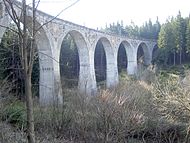
|
25.5 m | 197 m | without rail traffic, part of the route closed |
| Piesau Viaduct Lichte ( ⊙ ) |
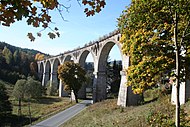
|
30.5 m | 258 m | without rail traffic, part of the route closed |
| Lippelsdorf Viaduct ( ⊙ ) |
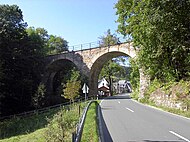
|
16.0 m | 62 m | without rail traffic, part of the route closed |
| Viaduct near Sommersdorf ( ⊙ ) |

|
24.0 m | 80 m | without rail traffic, part of the route closed |
| Viaduct in Graefenthal ( ⊙ ) |
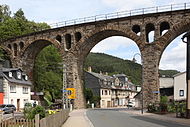
|
17.7 m | 81 m | without rail traffic, part of the route closed |
tunnel
The 220-meter-long Finstergrund tunnel, located on the section from Lichte to Ernstthal am Rennsteig in an arch directly in front of the viaduct of the same name, was slit open between 1933 and 1935 after constant water ingress and ultimately serious moisture damage. Today the 125 meter long Froschberg tunnel exists (in the disused section of the route).
additional
particularities
The Neuhaus am Rennweg station is 830.1 m above sea level. NHN one of the highest standard gauge stations in Germany.
Renaming
The Lichte (Thür) Ost train station was called Bock-Wallendorf until 1952 and the Schmiedefeld train station was called Taubenbach .
literature
- Wolfgang Beyer, Emil Ehle: Over the Rennsteig - From Sonneberg to Probstzella . Transpress-Verlag, Berlin 1983
- Wolfgang Beyer: Railway in the Sonneberger Land . Eisenbahn-Fachbuch-Verlag, Neustadt / Coburg 2004, ISBN 3-9807748-5-6
- Ulrich Rockelmann, Thomas Naumann: The Frankenwaldbahn. The story of the steep ramp over the Franconian Forest . EK-Verlag, Freiburg 1997, ISBN 3-88255-581-5
Web links
- Course book from 1944
- Route description Probstzella – Neuhaus
- Route 6688, pictures of the tunnel portals
Individual evidence
- ^ A b Hans-Joachim Kirsche: Railway Directorate Erfurt 1882-1993 . VBN Verlag B. Neddermeyer, Berlin 2006, ISBN 978-3-933254-76-4 , p. 64
- ↑ Wolfgang Beyer: Eisenbahn im Sonneberger Land , p. 113
- ↑ On the demolition see: Georg Schmidt and Rudolf Heym: Viadukt busted . In: Lok Magazin 3/2002, pp. 84–87
- ↑ See "Max and Moritz should rise again". In: FREE WORD. July 11, 2007, archived from the original on September 27, 2007 ; Retrieved November 13, 2010 .
- ^ Organization of the draisine operation by Schloss Wespenstein in Graefenthal. Retrieved January 29, 2019 .
- ^ Edmund Grollmisch: Probstzella - Ernstthal route: Citizens' railway and railway association want to cooperate. Ostthüringer Zeitung , November 10, 2016, accessed on November 16, 2016 .
- ↑ Meininger Tageblatt, April 7th 2016 edition, pp. 1 and 3
- ^ Ulrich Rockelmann / Thomas Naumann: The Frankenwaldbahn. The story of the steep ramp over the Franconian Forest. EK-Verlag, Freiburg 1997, ISBN 3-88255-581-5 , p. 140.
- ↑ a b Nahverkehrsservicegesellschaft Thüringen mbH (ed.): THÜRINGER REGIOTAKTE special edition , December 2002, p. 4, accessed on February 21, 2014
- ↑ a b Nahverkehrsservicegesellschaft Thüringen mbH (publisher): THÜRINGER REGIOTAKTE Extra Edition , October 2002 , p. 9, accessed on February 21, 2014



